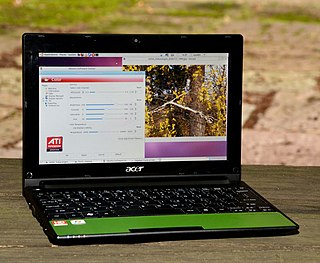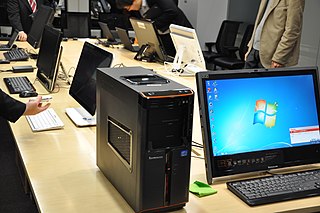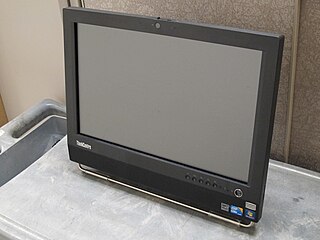
A desktop computer is a personal computer designed for regular use at a stationary location on or near a desk due to its size and power requirements. The most common configuration has a case that houses the power supply, motherboard, disk storage ; a keyboard and mouse for input; and a monitor, speakers, and, often, a printer for output. The case may be oriented horizontally or vertically and placed either underneath, beside, or on top of a desk.

Acer Inc. is a Taiwanese multinational company that produces computer hardware and electronics, headquartered in Xizhi District, New Taipei City, Taiwan. Its products include desktop PCs, laptop PCs, tablets, servers, storage devices, virtual reality devices, displays, smartphones, televisions and peripherals, as well as gaming PCs and accessories under its Predator brand. As of 2024, Acer is the world's sixth-largest personal computer vendor by unit sales.
In computing, instant-on is the ability to boot nearly instantly, allowing to go online or to use a specific application without waiting for a PC's traditional operating system to launch. Instant-on technology is today mostly used on laptops, netbooks, and nettops because the user can boot up one program, instead of waiting for the PC's operating system to boot. This allows a user to launch a single program, such as a movie-playing program or a web browser, without the need of the whole operating system. There still remain a few true instant-on machines such as the Atari ST, as described in the Booting article. These machines had complete Operating Systems resident in ROM similar to the way in which the BIOS function is conventionally provided on current computer architectures. The "instant-on" concept as used here results from loading an OS, such as a legacy system DOS, with a small hard drive footprint. Latency inherent to mechanical drive performance can also be eliminated by using Live USB or Live SD flash memory to load systems at electronic speeds which are orders of magnitude faster.

ThinkCentre is a brand for a family of business-oriented desktop computers, the early models of which were designed, developed and marketed by International Business Machines (IBM) since 2003. In 2005, IBM sold its PC business, including the ThinkCentre brand, to Lenovo. ThinkCentre computers typically include mid-range to high-end processors, options for discrete graphics cards, and multi-monitor support.

Small form factor is a term used for desktop computers and for some of their components, chassis and motherboard, to indicate that they are designed in accordance with one of several standardized form factors intended to minimize the volume and footprint of a desktop computer compared to the standard ATX form factor.
In computing, the motherboard form factor is the specification of a motherboard – the dimensions, power supply type, location of mounting holes, number of ports on the back panel, etc. Specifically, in the IBM PC compatible industry, standard form factors ensure that parts are interchangeable across competing vendors and generations of technology, while in enterprise computing, form factors ensure that server modules fit into existing rackmount systems. Traditionally, the most significant specification is for that of the motherboard, which generally dictates the overall size of the case. Small form factors have been developed and implemented.

Acer Aspire is a series of personal computers by Acer Inc. aimed at casual household users. The Aspire series covers both desktop computers and laptops. Acer developed the series to range from essentials to high performance. The Aspire mainly competes against computers such as Asus' Transformer Book Flip, VivoBook and Zenbook, Dell's Inspiron and XPS, HP's Pavilion, Spectre, Stream and Envy, Lenovo's IdeaPad, Samsung's Sens and Toshiba's Satellite.

Asus EeeBox PC is a nettop computer line from ASUSTeK Computer Incorporated, and a part of the Asus Eee product family. First released on August 11, 2008, the Asus EeeBox PC series is marketed as a small, light, inexpensive and energy-efficient counterpart to the Asus Eee PC netbook / subnotebook laptop series. Its motherboard employs Splashtop technology called Express Gate by Asus.

Acer Aspire One is a line of netbooks first released in July 2008 by Acer Inc.

A personal computer, often referred to as a PC, is a computer designed for individual use. It is typically used for tasks such as word processing, internet browsing, email, multimedia playback, and gaming. Personal computers are intended to be operated directly by an end user, rather than by a computer expert or technician. Unlike large, costly minicomputers and mainframes, time-sharing by many people at the same time is not used with personal computers. The term home computer has also been used, primarily in the late 1970s and 1980s. The advent of personal computers and the concurrent Digital Revolution have significantly affected the lives of people.

A mini PC is a small-sized, inexpensive, low-power, legacy-free desktop computer designed for basic tasks such as web browsing, accessing web-based applications, document processing, and audio/video playback.
Nvidia Ion was a product line of Nvidia Corporation intended for motherboards of low-cost portable computers. It used graphics processing units and chipsets intended for small products.
MSI Wind PC is a nettop counterpart to the MSI Wind Netbook. The MSI Wind PC is sold in Europe, Asia, and in the United States, barebones kits were available until Summer 2009, when desktop units also became available.

The Acer AspireRevo was a line of nettop computers from Acer Inc., first released at the end of April 2009. It is one of the first desktop computers to pair the NVIDIA ION chipset with Intel's Atom CPU.
The M-series of desktops are part of Lenovo's ThinkCentre product line. Formerly an IBM brand, Lenovo acquired the ThinkCentre desktop brand following its purchase of IBM's Personal Computing Division (PCD) in 2005. Following its acquisition of IBM's PCD, Lenovo has released M-series desktops in multiple form factors, ranging from traditional tower, small form factor, to ultra small form factor, and all-in-ones (AIOs).
The Lenovo IdeaCentre Q series are a line of nettop computers meant primarily for home and personal use. The Q Series nettops are described by the manufacturer as being multimedia-oriented nettops. Comparing the size to a typical paperback book, Lenovo describes the Q Series nettops as the smallest desktops in production. The general features of the Q Series desktops are the small size, low energy requirements, ability to play HD video, and low noise levels.

The Lenovo IdeaCentre is a line of consumer-oriented desktop computers designed, developed and marketed by Lenovo. The first IdeaCentre desktop, the IdeaCentre K210, was announced by Lenovo on June 30, 2008 as a consumer-focussed alternative to the business-oriented ThinkCentre and ThinkStation brandnames acquired from IBM. While the IdeaCentre line consists entirely of desktops, they share a common design language with the IdeaPad line of laptops and hybrids. One such feature is Veriface facial recognition technology.
Lenovo’s line of Essential desktops is a collection of budget-conscious machines designed for consumers, and advertised as being "affordable, space saving, and energy efficient". The Essential desktop line is different from both Lenovo’s ThinkCentre line and Lenovo’s IdeaCentre line. Lenovo defines its ThinkCentre desktops as business-oriented computers, while the IdeaCentre desktops are meant primarily for entertainment. The Essential range of desktops can be categorized as being between the two – meant more for ordinary everyday use.

The ThinkCentre Edge is a series of desktop computers from Lenovo, designed primarily for home offices and small businesses. The product series features desktops in both tower and All-in-One form factors, designed to save up to 70% desk space as compared to traditional tower desktop PCs.













